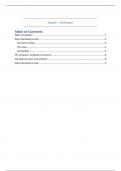Resume
Samenvatting History of Modern Africa
- Établissement
- Vrije Universiteit Brussel (VUB)
Samenvatting van het vak “History of Modern Africa” . Dit bevat de powerpoints, lesnotities en persoonlijke research. Het document volgt dezelfde structuur als de lessen.
[Montrer plus]








